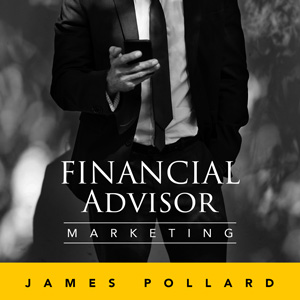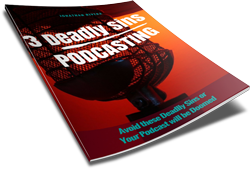You're listening to “Financial Advisor Marketing”—the best show on the planet for financial advisors who want to get more clients, without all the stress. You're about to get the real scoop on everything from lead generation to closing the deal.
James is the founder of TheAdvisorCoach.com, where you can find an entire suite of products designed to help financial advisors grow their businesses more rapidly than ever before. Now, here is your host, James Pollard.
James: Oh, boy. Do you ever feel like your day is going so well, like you're on fire, just crushing it, only to have something humble you and put you back in your place? That happened to me a few days ago. Let me set the stage for you.
I'm currently getting some work done on my house. I think that intelligent home upgrades and repairs are some of the best ways to simultaneously increase your home value and improve your quality of life. The job I'm doing right now involves a lot of lumber and some of that lumber was left in my driveway. It wasn't in the middle or anything. It was off to the side, but still in the driveway, enough that I felt the need to swerve around it as I was backing out of the garage. [01:12.0]
I got in my car and started backing out into my driveway. I saw the lumber in my backup camera and I wanted to make sure I didn't hit it. I'm a careful driver. We’ll see about that. You might wonder why I didn't just move the lumber. Why did I insist on driving around it? Two reasons. First, there was a lot of it and I'm lazy. Second, it seemed like it would be easy enough to just finesse my way around it.
Anyway, I'm backing out, backing out very slowly, and then, bam, I hear it. Ugh. I hit the lumber, or so I think. I get out of my car and I start walking to the rear to see what happened, and right at that time, my wife bursts through the garage and says, “Are you okay?” I tell her, “Yeah, I'm okay. I just hit this wood as I was backing out.” [02:02.7]
Then I saw her face change. It went from shock to relief, because I was okay—thank goodness, she's looking out for my wellbeing—and then back to shock again. After that, she points, takes her finger and just points, points, points. I follow the direction of her finger and see I didn't hit the lumber at all. Woohoo, good for me, right? Not exactly, because I hit the garage door, more specifically, the track the garage door uses to go up and down. Oh, and the sensor, too. I knocked that completely out, but the track was completely twisted 90 degrees. The entire section was just turned. Oh no, I thought to myself, just what I needed.
Let me tell you, nothing quite knocks the wind out of your sails like backing into your own garage door. Now, I'll spare you all the details, but I ended up fixing it myself. I actually used an axe to knock it back into place. Yes, that's true, and I made sure everything was operational. So, everything is okay. Everything works. It’s a little wonky. It looks a little wonky, but it is still operational. It is fully functioning. [03:08.1]
I was having a great day up to that point. I didn't have that much work to do. I had a few financial advisors email me and give me wonderful success stories. I love when that happens. I was on top of the world. Then, ba-bam, crush, that happened
Why am I sharing this little story with you? I want you to think about how I was trying to avoid one bad thing hitting the lumber and ended up having another bad thing happen. That's sort of like when financial advisors try to avoid taking risks or they try to avoid stepping outside of their comfort zone in their marketing. They might spend months obsessing over the perfect marketing campaign, or worse, avoid any kind of campaign or outreach that feels uncomfortable.
They want to avoid the lumber of potential rejection, awkward conversations, or the fear of seeming too salesy, whatever it is. They want to avoid a bad thing. But here's what happens: in trying so hard to steer clear of those small discomforts, they often end up hitting a much bigger obstacle—stagnation, usually the case for a lot of financial advisors. It could be something else. [04:12.2]
Looking back at my situation, I would have gladly hit the lumber instead of the garage-door track. I would have just booped the lumber on my tire and then stopped. Instead, I tried too hard to avoid it and the thing I feared came upon me. That's a Biblical lesson, if you get it. It’s from the Book of Job. It's a high-level thing we're not going to talk about in the podcast, but the thing I feared came upon me.
When financial advisors play it safe, avoiding bolder, more direct marketing tactics, they miss out on real growth opportunities. Just like I thought I could carefully back around the lumber, advisors often think they can move around what really works by staying comfortable. That's a bad move, because by avoiding discomfort now, they're setting themselves up for even more discomfort in the future. [05:00.4]
This might be a cheesy little metaphor, but marketing is a lot like what happened to me. Sometimes you need to clear out the obstacles and tackle challenges head on instead of hoping everything will be okay if you inch around them. In marketing, this means taking on the risk of doing what feels uncomfortable in the moment, meaning, I should have moved the darn lumber. Would it have been heavy and difficult, because there was a lot of it? Yeah, but not as difficult as what happened, not as difficult as me being embarrassed and trying to fix the garage track and taking an axe and whack, whack, whack, and trying to make it functional again.
So, in this episode, I'm going to share three difficult things I think financial advisors should do to set themselves up for long-term success. These are hard things that if you do them now, you'll avoid a lot of pain later. Let's begin.
No. 1: choose a niche. I say it all the time. I actually did an entire podcast episode about this in May of this year. The title is “The Big Fat Problem with Niche Marketing.” The gist of it is that niche marketing is difficult in the beginning, but easier in the long run. Being a generalist is easy in the beginning and progressively harder in the long run, because your systems and processes begin to fall apart. [06:13.4]
One of the reasons why I constantly talk about niche marketing is because it makes marketing easier, and in my opinion, you should be looking for every advantage you can get. A LinkedIn profile tailored specifically to a niche market is going to do so much better than someone with just “Financial Advisor” in the headline. A direct-mail campaign written directly to someone in a certain demographic or psychographic is going to crush compared to something sent to everyone.
Truthfully, being a generalist is risky with direct mail, because chances are, it's not even going to be profitable if you don't have a niche. I love direct mail. I recently did an entire podcast episode about it, but the actual mailer itself is only part of the battle. You have to have a good list, and that part comes from having a clear target market. [06:57.6]
Do I expect brand new financial advisors to have their niche markets figured out on day one? Absolutely not, but they should begin thinking about potential niches right away. They should begin forming an idea, getting the gears going in their head of who they can help the most, who is most likely to benefit from their services. Just something to consider, something to think about.
I also think it's okay to ease into your niche. The reason I say that is because it's usually a lot easier to go narrow later than it is to go wide later, especially as you grow your business. If your business is rocking and rolling, yeah, it gets a lot harder to do that, meaning, if you start trying to build your business around—I'm just going to get silly with this—redheaded pilots in Tennessee, age 50 and older, that might be a little too narrow. It's really hard to back out of that and say, “Never mind. That's not the niche I want.” [07:50.3]
It's a much smarter idea to draw a line in the sand and say, from the get go, “I'm only working with people 50 and older.” Then as you grow you can say, “I'm working with people 50 and older in Tennessee only,” and then you can go from there. Again, it’s easier to filter down as time goes on. I would much rather have you start slightly wider and niche down than to niche down too much and try to go wide later. I hope that removes a lot of the anxiety that financial advisors have about choosing a target market.
The No. 2 thing that is difficult in the beginning but will make life a lot easier for you is to build a phenomenal lead magnet. Your lead magnet is the thing that people get in exchange for joining your email list. In my experience, email marketing is arguably the single most effective marketing strategy financial advisors can employ for setting appointments. The reason it's so effective is because it allows you to handle objections, establish credibility, and build a relationship, one step, one email at a time. [08:51.4]
Plus, you can do it automatically using an email-autoresponder sequence, meaning, once you build the email sequence, you don't have to do much at all. You can just let it sit and run for you on autopilot, if you choose. But you have to get people on the email list, and your lead magnet is the thing that gets people to subscribe. It could be a PDF. It could be a video. It could be a webinar, or whatever you want, really, as long as it appeals to your specific target market. Personally, I like PDFs because they're easier to create in my experience, for me, but you might like videos. Videos might be easier for you to create. In any case, it has to be good, really good. [09:29.8]
Listen up, financial advisors. This is something special I'm doing exclusively for people who listen to this podcast. If you subscribe to the Inner Circle Newsletter over at TheAdvisorCoach.com/coaching, I will send you a collection of seven copyright-free emails, personally written by me, that you can use right away to begin getting more clients.
I call these my “objection-busting” emails, because they are designed to overcome the biggest objections financial advisors face. All you have to do is send me an email letting me know you’ve subscribed and I will reply with a link where you can download them for free.
I originally offered these in the May 2024 Inner Circle Newsletter issue, and it was one of the most popular bonuses I've ever given away. Today, these seven objection-busting, copyright-free emails are only available to listeners of this podcast, because I'm not mentioning them anywhere else. Go to TheAdvisorCoach.com/coaching to subscribe today. Now, back to the show.
One of my best performing league magnets, just to give you an idea, is an 80-plus page PDF. Another one of my best performing videos is nearly an hour long. The best webinar I ever did was 90 minutes long. That's not a coincidence. So many people try to get away with these little cheat sheets or guides or 15-minute videos and they don't work as well. Why? There are several reasons. [10:53.0]
The first reason is the familiarity principle, the mere exposure effect. The more people spend time with you, the more familiar they become with you, and the more likely they are to like you and do business with you. Second, something that's a little more in depth is just more appealing. That means it's more likely to get downloaded or to get someone involved in your world. Does it mean it absolutely has to be long? No, it doesn't have to be long, but it has to be good. So, if you can deliver something amazing that's not a long video or PDF, more power to you. It just has to appeal to your market.
In my experience, something that is more substantial simply has more appeal than something is skimpy. If I go to a dentist and I say, “Here's 100 pages of things that you could do to maximize the value of your practice,” and you go to a dentist and say, “Here are five pages of things you can do to maximize the value of your practice,” then I am likely going to get higher conversions than you. That's a reason why there is no such thing as a cookie cutter program or template that you can use, because it has to appeal to your market. [11:54.3]
A long time ago, I gave my Inner Circle members a lead-magnet template for them to model, but right there at the top, I gave them a warning, a disclaimer. I said, “Do not copy and paste.” Tailor it to your specific market. Tailor it to your situation, your background. Make it unique to you. Make it your own, because that is how you're going to get the most out of it.
A lot of financial advisors mistakenly believe that writing the emails themselves is the hardest, most time consuming part of email marketing. That is not true. That's actually really far from the truth. The emails should be the easiest part.
I even offer an entire sequence of seven copyright-free objection-busting emails to people who subscribe to the Inner Circle Newsletter, who listen to this podcast. It's the ad I have in the mid-roll. It's the middle of the podcast. It's in all of the recent podcast episodes. You could take that entire sequence of seven emails, modify them a little bit, put your name in there and a few stories about yourself, and have an email sequence up and running tonight. That is not an exaggeration. [12:51.4]
The podcast is the only place where I mentioned those objection-busting emails, because it's a bonus that I give only to Inner Circle members who listen to this podcast. It's my way of saying thank you for listening and thank you for becoming an Inner Circle member. At the same time, I like to reward people in my world, and that reward is reserved for them.
If you'd like to subscribe, shameless plug, you can go over to TheAdvisorCoach.com/coaching, and once you subscribe, send me an email letting me know you subscribed and I'll send back those seven copyright-free, meaning, you can use them however you want, objection-busting emails that you can use to create your own email sequence designed for you to set more appointments.
Oh, and by the way, if you've been on the fence about becoming an Inner Circle member, I'll say this one last thing, and then I'll move on, I promise. This is the last month that the newsletter will be $99 per month, because on January 1, 2025, I'm increasing the price to $199 per month. However, everyone who subscribes before January 1 will be locked in at $99 per month. That means this is quite possibly the best month ever to join, because the longer you stay subscribed, the more money you save, compared to someone who joins on January 1 or later. [14:02.1]
You could subscribe on December 31 at 11:58 p.m. for $99 per month, and someone else could subscribe on January 1 at 12:01 a.m., a mere three minutes later, and you will pay $100 less per month than that person, because you took action and you invested in yourself. Pretty sweet, if you ask me.
Now, where were we? Oh, yeah, hard stuff financial advisors do now to avoid pain later. No. 3: build your LinkedIn presence, or building a LinkedIn presence. LinkedIn is one of my favorite marketing strategies, so near and dear to my heart, and it is for several reasons.
One of the main reasons, and I alluded to this earlier, is because you have a headline that follows you around everywhere you go. And guess what? People read that headline. So, if you put something like, “Financial advisors serving tech employees,” and you get in front of tech employees, they are more likely to engage with you. Whoa, think of that. [14:58.0]
LinkedIn marketing also compounds over time. I've heard many stories from financial advisors who worry about how slow it is, how much effort they're putting in, and how little results they're getting. Then a few months later, they email me and talk about how glad they are that they stuck with it. Does that sound like investing money? I mean, you start off investing a little bit, and some more and some more, and a whole bunch of time goes by and the bulk of your investments are still from your contributions. You might start thinking to yourself, Gee, when is this compounding going to kick in? But you don't give up. You keep going. You keep contributing, and one day, you wake up and realize that your growth is outpacing your contributions. That's a pretty good feeling and LinkedIn is the same way.
To be clear, I am not an advocate of growth for growth's sake. I never have been and probably never will be. My LinkedIn approach for financial advisors is all about building relationships. I've said many times that you should have real conversations with people. Just be genuine. Stop trying to pitch everyone and send these long, weird messages. Just talk with people. Again, they will see your headline. [16:03.6]
Now, it's not that easy, but I can only give so much away on this podcast. I only have so much time. Still think about it this way if you're tempted by growth. How many clients do you need? I say this frequently. How many do you actually need? You probably don't need that many clients to make a fantastic living. You almost certainly don't need tens of thousands of LinkedIn followers and all of these notifications that don't add anything to your life.
You need a carefully cultivated group of people who know, like and trust you. You improve their lives and they improve your lives with the compensation they give you. That's how it's supposed to go. That's the backbone of a capitalistic society. You get rewarded in proportion to how much you help other people, how much you improve their lives, how much they're willing to pay you for perceived improvement. There are lots of ways to describe it. That is how it's supposed to be. [16:54.0]
Plus, your LinkedIn profile will be around. It's not going anywhere. It'll be there next year, then the year after that, in the year after that, assuming you don't do any weird stuff that gets you banned. Start building now. You'd be surprised at how many times people reach out to financial advisors and say things like, “I've been following you for months,” and that's the kind of compound interest I'm talking about. Every day you put it off is another day you have to wait for the compound interest, the compound effect, to kick in.
So, those are three hard things financial advisors should do now to set themselves up for success in the future. Let's recap, because this was kind of a fast episode.
No. 1: choose a niche and stick with it. You don't have to go super narrow in the beginning, but you should at least have some idea of a group of people you would like to work with.
No. 2: create a lead magnet that stands out in the crowded marketplace. I mean this sincerely, if you present your lead magnet to people in your audience, the response you're looking for is “Where can I get that?” They must want to get it, because if you can nail your lead magnet—here's a high-level tip for you—if you get your lead magnet right, then you can dramatically shift the economics of your business. [18:05.6]
If you have a lead magnet where you're essentially paying $50 per email subscriber, because it's not very good, and I come out swinging and I create an amazing lead magnet, and it gets me email subscribers for only $5 and we're going after the same audience, I have a tremendous economic advantage over you. It is worth the effort, especially because once it's created, it demands very little of your time. You don't really need to update it that much. You don't need to change it. It doesn't ask for anything. It doesn't cost you anything, in most cases. I mean, you could dress it up. You could do different things. You can make it what you want. But it's not like it's demanding a bunch of time or money.
No. 3: invest the time in LinkedIn, not just for the growth, but for genuine relationship-building, because I don't want to get all philosophical with you, but life is made up of the time you spend, and why not spend your time crafting an environment where you have a bunch of people you like in that environment? [19:00.8]
That's kind of what I've done with my Inner Circle Newsletter and my email list, and this podcast and all the things I do. I purposefully attract certain types of people, goal-oriented, achieving people, and repel others. That's because I'm designing the life I want to live and I'm doing it in service to others, and I think that's a great way to do it. I highly recommend it. It has worked well for me.
Okay, that is a wrap for this week's episode of the Financial Advisor Marketing podcast. Thank you so much for listening, and I will catch you next week. [19:30.3]
This is ThePodcastFactory.com




